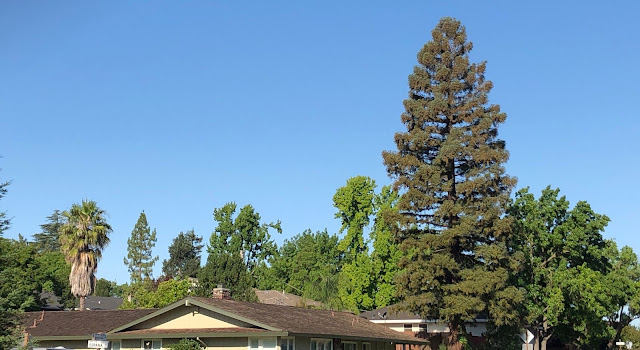Speaking for the trees: Don't forget them in this heat
 |
Just one street in a Sacramento suburb, but many types of trees, all with their own irrigation needs. (Photo: Kathy Morrison) |
By Kathy Morrison
My east-facing driveway is my early morning thermometer. When I step out there to pick up the newspaper or put something in my car, I can tell what kind of day we're going to have, especially in summer. (This morning: Pretty bad, but short of volcano heat.)
Just a few feet away, in the southeast corner of the yard, the air is at least 5 degrees cooler, and the grass is still refreshing on bare feet. That's thanks to the big redwood tree someone planted there several decades ago. Not a good choice for our climate, certainly, but that tree saves us money in air-conditioning costs for at least some of the day. It's also an entire habitat for the birds and squirrels, including the best lookout tower in the neighborhood for the local scrub jays.
I'd never get rid of that tree, so I baby it, and especially during drought and heat waves. (It's not the redwood in the photo above, by the way.)
Be good to your trees, and they'll continue to be good to you. Here are some tips from the Sacramento Tree Foundation and the UCCE master gardeners:
-- Know your trees! Native species of the Central Valley are well-adapted to the weather. Mature valley oaks, for instance, need just one or two deep waterings during the dry season. Redwoods like mine and other moisture-adapted trees (birches, magnolias, etc.) on the other hand, need regular deep waterings. And any tree that's planted near or in a lawn may have developed surface roots and have higher water needs. And young trees need more frequent irrigation than mature trees as they establish their roots.
-- Know your soil. Stick a screwdriver, a trowel or a soil probe into the soil around the tree about 6 to 12 inches. If the soil is dry and crumbly -- or rock-hard clay -- apply water slowly to soak down 12 to 24 inches. (See the tips at the end for ways to do this.) An estimated 85 percent of tree roots are in the top 18 inches of soil.
-- Know where to water. Irrigating at the base of a mature tree does nothing to help the roots, and might even cause rot. The roots extend out away from the tree much farther than you may think. Be sure to soak the root zone at least out to the drip line, defined as the soil beneath the edge of the leaves.
-- Know when to prune. During a heat wave, don't prune trees and other woody plants unless necessary (a cracked branch, for instance). Pruning stimulates shoot growth, which increases the need for water.
-- Know how to prevent rapid evaporation. Mulch, mulch, mulch! We say it a lot, because it works. Keep mulch a few inches away from the trunks of trees -- avoid "mulch volcanoes." Spread the mulch at least 3 inches deep across the root zone. This helps keep the soil cooler, will reduce weeds and will help retain soil moisture.
Methods of deep-watering trees:
-- Drip irrigation system that uses mini or micro sprinklers. (Make sure ANY sprinkler used doesn't splash water on the trunk or the base of the trunk.)
-- Soaker hose spiraled out to the tree's drip line. Reposition it as necessary.
-- A large, thin-plastic bucket with a couple of holes punched in the bottom. Position the bucket where you want to deep-water, fill the bucket and then let it soak in. Move the bucket and repeat. (This is labor intensive but does work, especially during drought water limitations. I found a 7-gallon clothes hamper that worked perfectly.)
-- Garden hose barely running. Also labor intensive (you have to move the hose a lot) but it will soak one area at a time quite well.
Prevent water runoff, of course, and don't water during windy conditions or during the middle of the day.
For more on water-efficient tree care, visit sactree.com/waterwise. To learn about branch drop -- common in summer -- read a previous post here.


Comments
Post a Comment